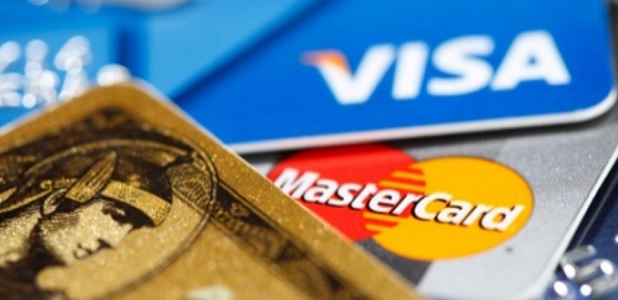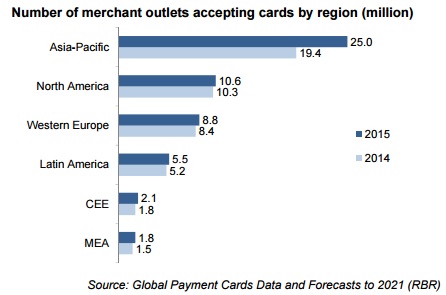
Rural expansion is driving rapid growth in card acceptance in developing markets, while regulation and new technology are boosting acceptance in more developed markets, according to RBR’s latest research, Global Payment Cards Data and Forecast to 2021.
Underserved regions are showing the fastest growth
RBR study says that the number of card-accepting merchant outlets worldwide rose by over 7 million in 2015 to 54 million. Growth was especially strong in Asia-Pacific, the Middle East and Africa (MEA) and central and eastern Europe (CEE) where payment card acceptance levels remain low.
In Asia-Pacific, the number of merchant outlets where customers can use payment cards increased by 29% in 2015. Unsurprisingly, China was responsible for much of this growth as a staggering 4.7 million new outlets began accepting payment cards during the year. Chinese merchants are racing to keep up with demand from the country’s vast population, especially in underserved rural areas.

Regulation is boosting card acceptance even in more mature markets
RBR has found that regulatory factors are having a positive impact on acceptance levels in several countries. For example, in Malaysia a reform on interchange fees came into force during 2015, encouraging merchants to begin accepting cards. Meanwhile in Kazakhstan, legislation has been introduced which requires all merchants to accept card payments or face a financial penalty.
Regulation is also bringing about further expansion in mature markets. For example, the business case for merchants in EU countries to accept card payments is stronger following the European Commission’s caps on interchange fees, which came into force in December 2015, and their knockon effect on merchant service charges.
Contactless and mPOS are extending acceptance to new sectors
In addition, technological advances are stimulating greater card acceptance even in developed markets. Contactless is appealing to merchants that handle low-value payments and appreciate the reduced transaction times that the technology enables. Meanwhile, mPOS devices are improving acceptance among mobile merchants, such as taxis and tradespeople, for which fixed terminals are
often not practical or cost-effective.
RBR’s Chris Herbert remarked: “Whether card acceptance is coming to an area for the first time, moving to lower value payments, or penetrating smaller merchants, the acquiring sector has a remarkable ability to find new opportunities for expansion.”
Source: rbrlondom.com
Banking 4.0 – „how was the experience for you”
„So many people are coming here to Bucharest, people that I see and interact on linkedin and now I get the change to meet them in person. It was like being to the Football World Cup but this was the World Cup on linkedin in payments and open banking.”
Many more interesting quotes in the video below: